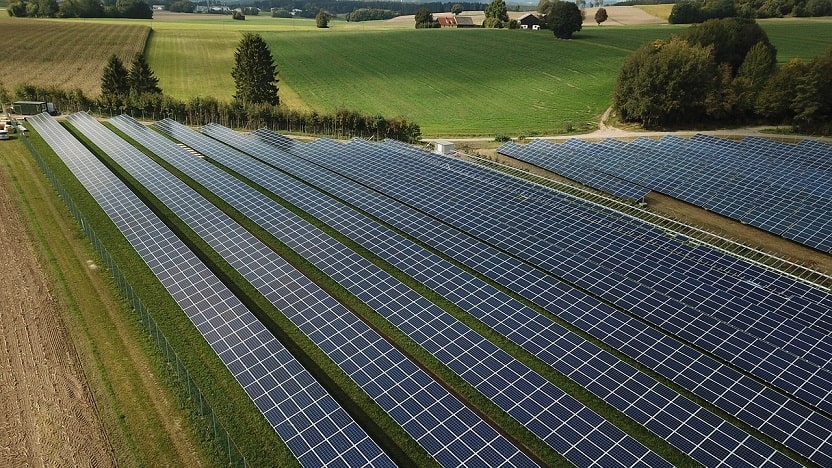Picture this: Vast fields of gleaming solar panels silently transforming sunlight into clean, profitable energy.

As traditional energy costs soar and fossil fuels face increasing scrutiny, solar farms are emerging as a lucrative investment opportunity.
But is 2024 the year to take the plunge?
Let's crunch the numbers and shed some light on this electrifying opportunity.
The Solar Advantage: More Than Just Hot Air
Solar technology has come a long way since its humble beginnings.
Today's photovoltaic (PV) panels are marvels of efficiency, with top-tier monocrystalline panels converting up to 22.8% of sunlight into electricity.
Polycrystalline panels (15-17% efficient) and thin-film panels (10-12% efficient) are budget-friendly options.
However, monocrystalline remains the top choice for large-scale solar farms.
They offer superior efficiency and longevity.
Breaking Down the Investment: Where Does Your Money Go?
Let's say you're eyeing a modest 1 MW solar farm investment.
Here's a detailed breakdown of where your $1 million might go:
- Panels: $600,000 (600 kW at $1/watt)
- Inverters: $80,000 (8 cents/watt)
- Mounting Systems: $70,000 (7 cents/watt)
- Installation: $150,000 (15 cents/watt)
- Permits & Grid Connections: $50,000
- Land Acquisition/Lease: $50,000 (varies widely by location)
This setup could potentially generate 1,600,000 kWh annually (based on 4.5 peak sun hours daily).
At an average selling price of $0.10 per kWh, you're looking at $160,000 in yearly revenue.
But here's where it gets interesting.
Factor in the 30% federal Investment Tax Credit (ITC), and your initial outlay drops to around $700,000.
With additional state and local incentives, you could be looking at a payback period of just 5-7 years.
Location, Location, Location (and Size!)
The success of your solar venture hinges on two critical factors: location and scale.
Sun-drenched regions like Arizona or California naturally offer higher electricity yields, maximizing your return on investment.
For instance, a 1 MW system in Phoenix might generate 1,750,000 kWh annually, compared to 1,400,000 kWh in Seattle.
Labor costs vary by location too, impacting your bottom line.
Installation costs in California might run 20-30% higher than in Texas or Florida due to labor rates and regulations.
When it comes to size, bigger is often better.
Larger systems tend to be more cost-effective per watt, as fixed costs like permits are spread across more panels.
A 5 MW behemoth might cost $0.80/watt to install, while a 1 MW setup could run $1/watt or more.
The Incentive Goldmine
2024 is shaping up to be a banner year for solar incentives, with federal, state, and utility programs all sweetening the pot:
Federal Boost
The Investment Tax Credit (ITC) remains a game-changer, offering a 30% tax credit on solar installations through 2032.
For a $5 million solar farm, that's a cool $1.5 million off your tax bill.
State-Specific Perks
- California: Farmers can snag up to $500,000 for solar-agriculture integration through the Renewable Energy for Agriculture Program (REAP).
- New York: Large community solar projects can earn up to $0.20 per watt through the NY-Sun Megawatt Block program, with extra incentives for pollinator-friendly designs.
- Illinois: Feed power back to the grid and earn $70 per Renewable Energy Credit through the Adjustable Block Program.
- Massachusetts: The SMART program offers fixed-rate incentives for up to 20 years, ranging from $0.13 to $0.39 per kWh depending on utility and project size.
Utility Company Carrots
Duke Energy (North Carolina): $0.065 per kWh for solar farms with battery backup.
- Xcel Energy (Minnesota): $0.07 per kWh for 10 years on systems up to 40 kW through their Solar*Rewards program.
- Arizona Public Service: Rebates of $0.50 per watt for systems up to 1 MW, significantly reducing upfront costs.
- Green Mountain Power (Vermont): Additional $0.01 per kWh for the first 10 years for projects meeting specific siting criteria.
Challenges on the Horizon: Not All Sunshine and Rainbows
It's not all smooth sailing in the solar sea.
Zoning regulations can be a maze, and the land use debate rages on.
Grid connection delays are common, with wait times of 12-18 months not unusual in some areas.
Market fluctuations can impact project economics, and power purchase agreement terms require careful scrutiny to avoid long-term unfavorable conditions.
Technical hurdles like soil suitability and maintenance costs need careful consideration.
Annual maintenance might run 1-2% of total system cost, while inverter replacement (every 10-15 years) could set you back $0.10/watt.
Environmental regulations now require impact studies, complicating project planning.
Innovative approaches like agrivoltaics (combining solar with agriculture) are emerging to address land use concerns, but they come with their own set of challenges and costs.
The Bottom Line
Solar farms in 2024 offer a tantalizing blend of profitability and sustainability.
With careful planning, site selection, and a keen eye on incentives, you could be harvesting more than just sunlight you could be reaping significant financial rewards.
Let's run the numbers on our 1 MW example:
- Annual Revenue: $160,000
- Operating Expenses (2% of system cost): $20,000
- Net Annual Income: $140,000
- Initial Investment (after 30% ITC): $700,000
- Simple Payback Period: 5 years
Factor in additional state incentives, potential increases in electricity prices, and the 25+ year lifespan of modern solar panels, and the long-term profit potential becomes even more attractive.
As with any investment, due diligence is key.
Partner with experienced developers, consult financial experts, and stay informed about local regulations and market conditions.
Weather events and rapid technological advances may risk outdated systems, so factor in potential upgrades and insurance costs.
In a world hungry for clean energy, solar farms are more than just a smart investment.
They're a beacon of hope for a greener, more sustainable future.
So, is 2024 your year to shine in the solar market?
The numbers suggest it just might be. Time to harness that solar power and turn sunshine into gold!